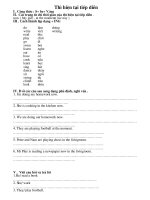4 5 4 lets explore antarctica
Bạn đang xem bản rút gọn của tài liệu. Xem và tải ngay bản đầy đủ của tài liệu tại đây (7.02 MB, 14 trang )
Suggested levels for Guided Reading, DRA,™
Lexile,® and Reading Recovery™ are provided
in the Pearson Scott Foresman Leveling Guide.
Earth Science
et’s
L xplo
xplor
r
e
Enta
Antarrctica!
by Colin Kong
Genre
Expository
nonfiction
Comprehension
Skills and Strategy
• Main Idea and
Details
• Generalize
• Text Structure
Text Features
•
•
•
•
Charts
Diagrams
Heads
Maps
Scott Foresman Reading Street 4.5.4
ISBN 0-328-13482-1
ì<(sk$m)=bdeicd< +^-Ä-U-Ä-U
Reader Response
et’s
L xplo
xplorre
Enta
ntar
r
c
tica
!
A
1. State one main idea from this book. Give one or
two details that support this main idea.
2. You read about the extreme conditions of
Antactica. Complete the chart below.
Effect
Cause
1a.) Very cold
temperatures
2a.)
by Colin Kong
3a.) Gravity pulls cold
air to the ground
1b.)
2b.) Sastrugis form
3b.)
3. Some words in this book have Greek or Latin
roots. For example, the word geography comes
from the Greek words geo (earth) and graphy (to
write or carve). Look up the following words in a
dictionary, and write their definitions: annually,
migrate, aquatic. See if you can find the roots of
these words.
4. Look at page 23. What are some different ways to
describe how winds change the Earth’s surface?
Editorial Offices: Glenview, Illinois • Parsippany, New Jersey • New York, New York
Sales Offices: Needham, Massachusetts • Duluth, Georgia • Glenview, Illinois
Coppell, Texas • Ontario, California • Mesa, Arizona
Every effort has been made to secure permission and provide appropriate credit for
photographic material. The publisher deeply regrets any omission and pledges to
correct errors called to its attention in subsequent editions.
Unless otherwise acknowledged, all photographs are the property of Scott Foresman,
a division of Pearson Education.
Photo locators denoted as follows: Top (T), Center (C), Bottom (B), Left (L), Right (R),
Background (Bkgd)
Cover ©Galen Rowell/CORBIS; 1 ©Ralph A. Clevenger/CORBIS; 3 ©Bettmann/CORBIS; 7
©Ann Hawthorne/CORBIS; 8 ©Peter Johnson/CORBIS; 9 ©Ralph A. Clevenger/CORBIS;
10 ©Galen Rowell/CORBIS; 11(T) ©Herb Schmitz/CORBIS; 11(TC) ©Galen Rowell/
CORBIS; 11(BC) ©Tim Thompson/CORBIS; 11(B) ©Galen Rowell/CORBIS; 12(B) ©Images.
com/CORBIS; 13 ©Bettmann/CORBIS; 14 ©Tim Davis/CORBIS; 15(T) ©Rick Price/CORBIS;
15(C) © Reuters/CORBIS; 17 ©Tim Davis/CORBIS; 18 ©Peter Johnson/CORBIS; 19 ©Ann
Hawthorne/CORBIS; 20 ©Galen Rowell/CORBIS; 21 ©Peter Johnson/CORBIS; 22(T)
©Galen Rowell/CORBIS; 22(C) ©Royalty-Free/CORBIS; 22(B) ©Peter Johnson/CORBIS
ISBN: 0-328-13482-1
Copyright © Pearson Education, Inc.
All Rights Reserved. Printed in the United States of America. This publication is
protected by Copyright, and permission should be obtained from the publisher
prior to any prohibited reproduction, storage in a retrieval system, or transmission
in any form by any means, electronic, mechanical, photocopying, recording, or
likewise. For information regarding permission(s), write to: Permissions Department,
Scott Foresman, 1900 East Lake Avenue, Glenview, Illinois 60025.
2 3 4 5 6 7 8 9 10 V0G1 14 13 12 11 10 09 08 07 06 05
Antarctica is a continent located at the
southern pole of our planet. In fact, Antarctica is
one of the polar ice caps. The other polar ice cap
is at the northern pole of the planet.
If you are planning to depart for Antarctica,
be sure to pack plenty of warm clothing. It is
a land of extremes. Fierce winds and blinding
storms are common there. In fact, Antarctica
is the coldest, highest, windiest, and driest
continent on earth!
Nobody really lives in Antarctica. The land
is mostly untouched. No country owns
Antarctica, either. Instead,
different countries
have signed an
agreement to study
Antarctica. Among
other things, they
study the effects
of wind, water,
and light on the
Antarctic surface.
Antarctica: Land of Extremes
Coldest
World low temperature record of -129º F
(- 89.4º C ) at Vostok on July 21, 1983
Highest
Average elevation of 8200 ft. (2500 m)
Windiest
Gale winds reach 200 mi/hr (320 km/hr)
on Commonwealth Bay, George V coast
Driest
Average precipitation is less than
2 in. (5 cm) per year
3
Antarctica’s Chilly Surface
Blizzards and cold temperatures can threaten
the scientists who come to study Antarctica.
Sometimes they have to stay inside their tents for
days at a time because the winds are too strong.
They wait with anticipation for the terrible
weather to stop.
Imagine that you are in the middle of
Antarctica. What do you see? Snow, ice, and
more ice! More than 99% of the continent is
covered in ice—about 5.3 million square miles
(13.7 million square kilometers). The Antarctic
Ice Sheet is millions of years old and up to three
miles deep.
Why is Antarctica so important? For starters,
around 90% of the fresh water on the Earth’s
surface is found in this Ice Sheet. Also, about
90% of the world’s ice is found on this continent.
All oceans around the world contain water that
came from the ice of Antarctica. If the Antarctic
Ice Sheet were to melt, the ocean’s waters would
rise by 196 to 213 feet (60 to 65 meters). This
would create terrible flooding.
I N D I A N
O C E A N
Mo
est A
An
nta
ar
An
tE
ev
rm
ake
P A C I F I C
O C E A N
4
5
The Geography of Antarctica
The Desert of Antarctica
Antarctica consists of two very different
geological regions. East Antarctica is a vast area
the size of the United States. It is made up of
continental crust—the Earth’s surface. Here the
ice sheet averages 1.6 miles (2.57 kilometers)
in thickness. It rarely breaks up because it sits
squarely on top of the Earth’s surface.
Did you know that Antarctica can be called
a desert? Not all deserts are hot and dry. A
desert is an area that gets less than 10 inches
(25.4 centimeters) of precipitation in one year.
Antarctica falls into this category.
The inner part of the continent receives two
inches of moisture in the form of snow per year.
This is less moisture than the Sahara Desert gets.
Antarctica’s coasts get a little more snow—about
eight inches of precipitation per year. Heavy
snowfalls occur when storms pick up moisture
from the seas.
In most deserts, precipitation evaporates. In
Antarctica, the precipitation never evaporates.
The snow never goes away. It builds up over
hundreds of thousands of years and creates very
thick ice sheets. As a result, Antarctica’s surface
only gets thicker.
Much of the
West Antarctic
Ice Sheet is
below sea level.
Much of West Antarctica—the smaller part of
the continent—is below sea level. In some places
it can be as much as 1.5 miles (2.4 kilometers)
below sea level. Because of this, the West
Antarctic Ice Sheet breaks up more easily than
the East Antarctic Ice Sheet. In West Antarctica,
enormous floating blocks of ice, or glaciers, are
in constant motion. The ice can crack and break.
For this reason, the landscape is always changing.
Antarctica also has mountains as high as
16,400 feet (5,000 meters). The Transantarctic
Mountains divide the continent in two. Most of
this range is buried under ice. Part of this range
forms the Antarctic Peninsula, which sticks out
into the sea like a tail.
6
In parts of Antarctica, called the Dry Valleys,
it has not rained for at least two million years!
7
Snow crystals accumulate year after year
to form dense ice on Antarctica’s surface.
The Antarctic Ice Sheet
How thick is the Antarctic Ice Sheet? No one
knows for sure. Scientists have measured one
deep hole in West Antarctica called the Bentley
Subglacial Trench. It is 8,200 feet (2,499 meters)
deep. It’s covered with more than 9,843 feet
(3,000 meters) of ice and snow. In fact, some
scientists believe the layer of ice could be up to
16,400 feet (5,000 meters) thick!
How does the ice get so thick? Remember,
the temperatures in Antarctica are below 32°F
(0°C)— even in the summer. Frost and snow
crystals that fall on the ice sheet’s surface never
melt. They accumulate annually, and the crystals
begin to be buried by the weight of the crystals
above them. After awhile, the snow crystals get
compacted and form dense ice. Antarctica has an
average elevation of 7,550 feet (2,300 meters). It
is the ice that makes the elevation so high.
8
Scientists have
studied what
is beneath
icebergs, but
the evidence is
inconclusive.
The Mystery of Antarctica
With so much ice in Antarctica, there is no
telling what is underneath the icy surface. Some
scientists think there is volcanic activity under
certain areas of the ice. They have found places
where glaciers and ice streams flow more quickly.
Scientists think volcanic activity melts the ice.
Then the quickly flowing water causes Antarctic
glaciers and ice streams to move faster. It is
amazing to imagine volcanoes erupting under
the surface of the polar ice cap!
9
Danger! Icebergs!
Antarctica’s ice sheets are always changing.
Sometimes they crack and break. Along the
coasts of Antarctica, when an enormous piece
heaves into the sea, it becomes a floating
mountain of ice.
Icebergs then start drifting and moving
around, depending on wind speed, wind
direction, surface currents, and the size of the
iceberg. When the wind and currents move
icebergs, they act as if they had minds of their
own. Icebergs can present very real and pressing
dangers to ships that cross in their paths.
Definitions of Ice Terms
Ice Domes
Ice domes are slow moving
areas of ice and snow on an
ice sheet. They are dome
shaped, and ice flows from
the center of the dome. An
ice sheet can have several ice
domes.
Ice Streams and
Outlet Glaciers
Ice streams and outlet
glaciers are the fastest
moving areas of an ice
sheet. They move ice away
from ice domes quickly.
Ice Shelves
An ice shelf is a floating ice
mass that is attached to an
ice sheet on at least one
edge. The Ross Ice Shelf in
Antarctica is the largest in
the world. It is the size of
Texas!
A man standing
next to an
iceberg looks
like a tiny ant.
10
Icebergs
Icebergs are pieces of
floating ice that break off
from ice shelves, outlet
glaciers, or ice streams.
There are many shapes and
sizes of icebergs. Ice shelves
produce the majority of
icebergs. They also produce
some of the largest icebergs.
11
The movement
of icebergs
depends on
many factors
such as
wind speed
and surface
currents.
Icebergs and Sea Currents on the Move!
Winds blow icebergs all around the coast
of the continent. Icebergs usually move slowly,
and sometimes get stuck in shallow areas. The
larger icebergs travel around the continent and
eventually migrate to the Weddell Sea. There,
they often get stuck. That is why there are large
numbers of icebergs along the east coast of the
Antarctic Peninsula.
The number and size of icebergs get smaller as
you move away from Antarctica. Waves, storms,
and warmer waters slowly break down icebergs
as they move away from the southern pole.
Slowly icebergs melt into the sea.
An iceberg may look
large on the surface,
but you are not
seeing the whole
picture. The part of
the iceberg under the
water can be almost
ten times larger in
size!
12
The Tragedy of the Titanic
Did you know that nine-tenths of an iceberg
is underwater? Even if you see an iceberg,
you can’t tell the size of its underwater part.
Scientists have found some icebergs that sit
deeper than 984 feet (300 meters) under the
water. The biggest iceberg discovered was 183 mi
(295 km) long and 23 mi (37 km) wide. Its surface
area was the size of the Bahamas or the state of
Connecticut! Its underwater part was 10 times
larger than the part that was visible above water.
All ships try to avoid the path of an iceberg.
Icebergs are so hard that they can break rocks.
Running into an iceberg is like running directly
into a concrete wall. Every crew knows that by
the time you see an iceberg up close, it may be
too late to avoid crashing into it since its biggest
part is underwater.
In 1912, the huge luxury ocean liner RMS
Titanic hit an iceberg on its first journey across
the Atlantic. Within hours, the ship—thought
to be unsinkable—broke in two and sank in
icy waters. Many passengers were rescued,
but many more died.
After running
into an iceberg,
the RMS Titantic
ocean liner sank.
13
Water, Salty Ice, and Light
Water from clouds affects the thickness of
Antarctica’s surface. Water from the sea has a
different effect. The ocean around Antarctica
forms sea ice, which is a type of salty ice. In
the winter, the area of sea ice formed is about
one and a half times the area of the continent.
During the other seasons, the sea ice melts
to cool both the ocean and the atmosphere.
Because the amount of sea ice around its coasts
keeps changing, the size of Antarctica grows and
shrinks throughout the year.
With such low temperatures all year long,
sunlight does not have much of a warming effect
on Antarctica’s surface. It may be affected by
ultraviolet light, however. Ultraviolet (UV) light
from the sun is absorbed by the Earth’s ozone
layer.
The hole in the ozone
layer lets more ultraviolet
light come through the
Earth’s atmosphere.
The increase in UV rays
is harmful to Antarctica’s
penguins and fish.
Dangers of the Ozone Layer
14
There is a hole in the ozone layer which
poses a big problem for plants and animals in
Antarctica. This hole means that more ultraviolet
light is entering the Earth’s atmosphere.
Ultraviolet rays also go into the ocean’s waters.
As a result, they harm Antarctica’s aquatic life,
such as fish and marine plants.
It isn’t just plants and fish that are in danger.
Researchers and scientists in Antarctica also
need to be careful to protect themselves from
these harmful rays. These rays do not directly
affect Antarctica’s surface, but they affect life
on the surface.
15
Katabatic winds
form when cold
winds rush down
a steep slope.
The strongest
katabatic winds
are found in
Antarctica.
The Effects of Wind
Strong winds are always blowing in Antarctica.
Calm periods are rare and usually last only a few
hours. At times, it seems as if Antarctica gets
more snowfall than it really does. This is because
the winds pick up snow from one place and move
it to another. The strongest winds are katabatic
winds.
The center of the East Antarctic Ice Sheet is
called the Polar Plateau. Here, the air is especially
cold. The colder the air is, the more dense and
heavy it becomes. Because the air is heavy, it
settles close to the ground. Due to gravity, the
cold and dense air then flows from the interior
of the continent toward the coast. Think of a
river and you will have an idea of how this cold
air flows along Antarctica’s surface.
Most winds from the interior of the continent
move over gentle slopes. Different grooves in
the land cause a convergence of air. When air
converges, the wind strengthens. Incredibly
intense winds, called katabatic winds, pick up
speed.
16
Gravity’s Effect on Winds
Gravity also affects the speed of katabatic
winds. It can cause wind speeds to suddenly
increase from zero to 33.5 to 44.75 miles per hour
(15 to 20 meters per second)!
There are two types of katabatic winds.
Ordinary katabatic winds flow in one direction,
but wind speeds change a lot. Extraordinary
katabatic winds can blow for days or weeks at
very high speeds.
Katabatic winds can be found in many places
around the world. These winds are created when
cooled air moves down a steep slope. Antarctica
has the strongest katabatic winds on the planet.
Winds are constantly blowing on the
continent. The windiest spot on Earth is
Cape Denison in Antarctica. Wind speeds
here have reached up to 200 miles per hour
(320 kilometers per hour).
17
When the weather conditions become
dangerous, researchers and scientists
need to stay inside their tents until the
wind dies down.
Antarctica’s Cape Denison is sometimes called
the Home of the Blizzard.
Winds Shape Antarctica’s Surface
Danger! Katabatic Winds and Blizzards!
Katabatic winds are most active in winter.
They can reach high speeds as they come close
to the coast. Katabatic winds have slower speeds
at the center of the continent. The windiest spot
on Earth is Cape Denison in Antarctica. This is
where katabatic winds converge. Sometimes
wind speeds reach up to 200 miles per hour (320
kilometers per hour).
It is not easy for researchers to study katabatic
winds. Not only are they very strong, but they
also carry ice crystals.
18
Blizzards also occur frequently in Antarctica.
Sometimes they are so strong, they create what
is called a “white-out.” This means that there is
so much snow in the air, you cannot see around
you. Both the winds and these blizzards make
Antarctica a forbidding place to visit.
All these different winds have a great effect
on Antarctica’s lands and coasts. When the strong
winds move across the continent, they scrape,
grate, and sculpt the icy surface. The shape of
the surface is always changing and is never flat.
The combination of strong winds and snowfall
forms ridges of snow and ice. These ridges are
called sastrugis, and they look like ice bumps or
waves of snow.
19
The Shape of Snow
Wind, Salt, and Waves
When you look out at Antarctica’s surface,
you can see miles of sastrugis. They are
everywhere, and they seem to go on for miles
and miles. They can be any size too. Sastrugis
can be a few centimeters high. They can also be
up to three meters high. It is impossible to avoid
them. If you wanted to walk across Antarctica—
which would be very dangerous—you would
find it difficult! You might be walking on a flat
surface. Then, all of a sudden, the ground might
drop two or three feet.
Powerful winds also affect the coasts of
Antarctica. They are so strong that they can push
away the sea ice, exposing new areas of water
to the air. The winds cool the open areas and,
gradually, new ice forms.
Ocean water has a lot of salt in it. When new
ice forms, a lot of salt is left behind. This makes
the water below the ice of Antarctica the saltiest
and densest on Earth.
With no other lands nearby to stop them,
the rough Antarctic winds circle the continent,
creating huge waves. The waters around the
continent are known to be some of the roughest
seas on Earth. It is definitely not a place for
people who get seasick easily.
Ships often have a hard time in the
rough seas around Antarctica.
The winds create designs of snow.
When the snow hardens into ice,
these ridges become hard as rocks.
20
21
Strong winds scrape,
grate, and sculpt
Antarctica’s surface
to form interesting
designs. The icy
surface is always
changing.
E F F EC T S OF W IND
Winds push sea ice away
from Antarctica’s coasts. New
sea ice is formed in the open
area. As the ice forms, salt
is left behind in the waters.
These waters are the saltiest
of all the oceans.
Fierce winds create
huge waves in the
seas. The ocean
around Antarctica is
one of the roughest
seas on Earth.
22
How Does Nature Change
the Surface of the Earth?
In Antarctica, scientists study how extreme
conditions affect the continent’s surface. They
study the effects of extreme wind, water,
and ultraviolet light. Their findings help us
understand how the same factors affect other
parts of the Earth.
You don’t need to be a scientist to see how
wind, water, and light affect the Earth’s surface.
Look right in your own backyard! Winds can
blow down trees, or rains can overflow lakes and
rivers. Changes can happen over a long period of
time, or they can happen all of a sudden.
At the beach, you may notice that water from
the ocean washes away the sand. Beaches can
erode over time. Soil can also erode. Wind can
blow it away, and water can wash it away. Winds
beating against hills and mountains can make
rocks smooth as glass over time.
Weather can greatly change the Earth’s
surface in a very short period of time. Think
how damaging hurricanes, tornadoes, and
earthquakes can be. They can destroy everything
in their paths. Rains can mix with soil to create
mudslides. Earthquakes can create deep cracks in
the ground. These natural changes to the Earth’s
surface can happen in Antarctica or anywhere
else in the world.
23
Glossary
anticipation n. act of
looking forward to;
expectation
continent n. one of the
seven main land masses
of the Earth, including
Africa, Antarctica, Asia,
Australia, Europe, North
America, and South
America
convergence n. the act
of coming together
Reader Response
depart v. to go away
or leave
1. State one main idea from this book. Give one or
two details that support this main idea.
forbidding adj. harshly
uninviting
2. You read about the extreme conditions of
Antactica. Complete the chart below.
heaves v. throws itself
icebergs n. massive
floating bodies of ice
broken away from an
outlet glacier, ice shelf,
or ice stream
Effect
Cause
1a.) Very cold
temperatures
2a.)
1b.)
3a.) Gravity pulls cold
air to the ground
3b.)
2b.) Sastrugis form
3. Some words in this book have Greek or Latin
roots. For example, the word geography comes
from the Greek words geo (earth) and graphy (to
write or carve). Look up the following words in a
dictionary, and write their definitions: annually,
migrate, aquatic. See if you can find the roots of
these words.
4. Look at page 23. What are some different ways to
describe how winds change the Earth’s surface?
24









